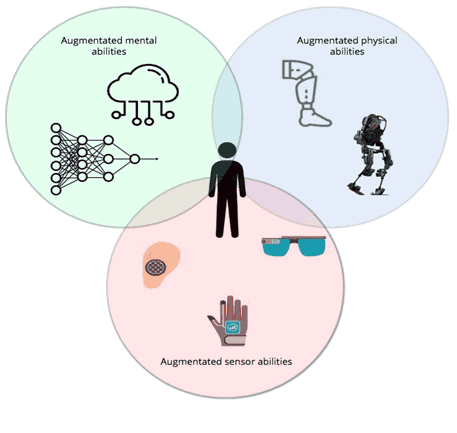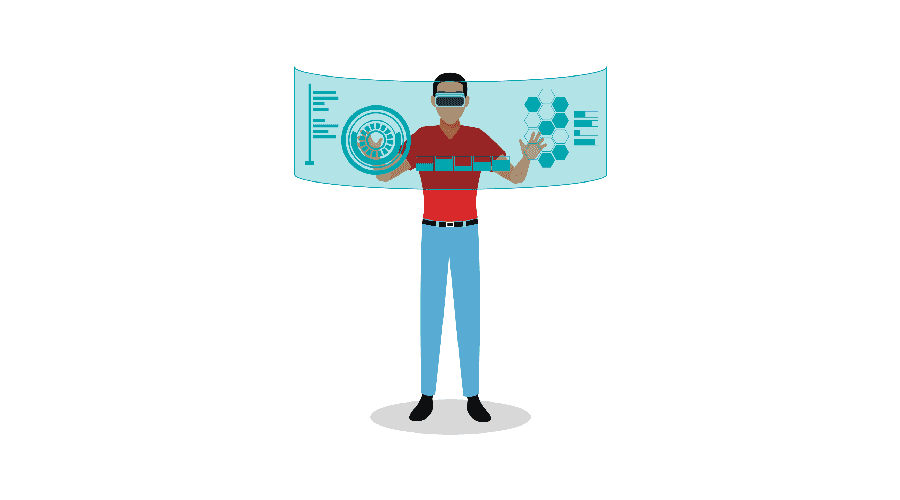Humans have been adapting to computers for a long time, but human augmentation introduces a new way of utilizing computing power. Now, humans leverage technologies to enhance their natural abilities for better outcomes.
Millions of people are already interacting with human augmentation technologies to improve their lives and bodily functions. Replication technologies, for example, focus on recreating human functions that are almost depleted.
Prosthetics can replicate amputated legs or fingers, Cochlear implants recreate hearing, while some wearable devices with cameras enable blind individuals to see. All such inventions demonstrate the possibilities of human augmentation technology.
Experts predict that the market will have a net worth of 400 billion dollars by 2027. In this article, we explain the different forms of human augmentation, how it works, and the ethical considerations of this technology.
What is Human Augmentation Technology?
Human augmentation technology is an invention that enhances human capabilities, elevating human health, performance, and quality of life. It also applies to how humans and machines collaborate, as evidenced by the growing applications of artificial intelligence.
Human augmentation technology takes on various forms:
- Augmented senses: This technology enhances human senses by interpreting multi-sensory information. Sub-classes include augmented hearing, vision, smell, haptic sensation, and taste.
- Augmented cognition: This is the use of technology to aid an individual’s cognitive process. It aims to improve memory, decision-making, and attention.
- Augmented action: The focus here is on improving human physical abilities. Thus, the technology is designed to help humans perform more precise functions, e.g., by using robotics.
Although human augmentation technology is closely related to other concepts, such as assistive and rehabilitative technologies, its methodologies and applications differ. Human augmentation focuses on enhancing physical and cognitive abilities, while other technologies help individuals perform tasks that would otherwise be impossible.
Assistive technology, for example, refers to tools and devices that help individuals with disabilities achieve greater independence and improve their quality of life. These can include mobility aids (e.g., wheelchairs), hearing aids, communication aids, and home modifications like stair lifts and ramps.
On the other hand, rehabilitative technology is a set of medical and therapeutic interventions that help patients recover from surgeries, injuries, or illnesses and regain lost functions. These interventions could be technological aids like robotic rehabilitation systems, speech therapy interventions, or physical therapy.

Types of Human Augmentation Technology
Human augmentation technology encompasses various advancements designed to enhance human capabilities. The technology can be divided into three categories:
Replicating Human Abilities
These are human augmentation technologies that can replicate human abilities. Examples include voice synthesizers for the mute and prosthetic limbs for people with disabilities.
Naked Prosthetics is one company that has leveraged the power of human augmentation to develop finger prosthetics for people whose fingers have been amputated.
Supplementing Human Ability
These human augmentation technologies improve one’s ability to execute or perform a task. They could be devices that increase intelligence, strength, or enhance eyesight beyond normal limits.
An excellent example is ThirdEye’s Mixed Reality Smart Glasses, which allow you to call anyone and see their 3D hologram.
Exceeding Human Ability
This human-augmented technology enables you to perform activities you’d not naturally do. It could be smelling chemicals that can’t be detected by the human olfactory sense, flying, or seeing.
Elon Musk’s Neuralink brain chip is an excellent example. The device is implanted in an individual’s brain to improve cognitive function and treat neurological conditions.
Real-World Use Cases of AI Analytics
Various companies have developed devices that leverage human augmentation technology to enhance cognitive abilities and overcome physical limitations. Here are real-world examples:
Chatbots: For Personalized Shopping
Experts use AI technology to develop chatbots and virtual shopping assistants to help businesses engage better with customers.
The chatbots use information such as the customer’s interests, browsing history, and preferences to make recommendations and natural language processing to personalize the conversation.
These tools personalize the customer’s experience, cultivating the customer’s loyalty to the brand.
Teslasuit: For Simulation
Tesla developed a wearable outfit that can track the user’s movement, control their temperature, and provide feedback.
Teslasuit is a full-body haptic feedback suit equipped with biometric monitoring capabilities, feedback sensors, and motion capture technology to create immersive sensory experiences in virtual environments. It can simulate physical sensations and monitor their physiological responses in real time.
Companies in the sports, healthcare, aerospace, and gaming industries can leverage their capabilities to develop products that improve our quality of life.
A physical therapist, for example, can monitor a patient’s stress levels using the intelligent suit and use that information to prescribe medication. Also, athletes can use the suit to make the perfect athletic pose or movement, e.g., a golf swing during sports training.
Skylight: Enhances Efficiency in the Aerospace Industry
Skylight glasses were developed to help aerospace engineers tighten B-nuts, crucial components in jet engines.
They can detect when an engineer is tightening a B-nut and determine if it has been tightened correctly. The glasses provide real-time instructions and visual overlays within the user’s field of view, reducing errors during assembly.
EksoWorks: Exoskeletons for rehabilitation
Ekso Bionics has an entire lineup of exoskeletons to help construction workers improve performance. Users wear the devices to enhance endurance, artificial strength, and recovery after an injury. Experts predict exponential growth in this market, reaching $1.9 billion by 2025.
The device is available in multiple variations, helping users in manufacturing, construction, and the military. The HULC, for example, is designed to help soldiers carry heavy equipment over long distances in combat situations.
eSight: To Help the Blind to See
This wearable device resembles regular glasses, but it’s designed to help people who are legally blind regain vision. eSight smart glasses have cameras that display the surroundings on a screen in front of the user’s eyes.
The company recently upgraded the glasses, producing lighter, smaller, glasses equipped with easier-to-navigate software.
How Does Human Augmentation Work?
The essence of human augmentation is to enhance natural human capabilities, and various computing technologies have made this possible.
They have enhanced human productivity, improved, and restored the capabilities of the human body and mind. Key technologies driving human augmentation include:

Biotechnology
Human augmentation technology enhances human senses, cognitive processes, and physical abilities and biotechnologies play a critical role in making this possible.
Biotechnology is the use of biological processes and cellular compounds to develop new technologies and products. Through techniques like CRISPR, biotechnologists can modify human genes to enhance physical and cognitive traits.
This recent invention now helps researchers perform gene editing DNA and find new ways of treating long-term illnesses like cancer and blood disease.
Robotics and AI
Robotics have helped the human body perform highly complex functions and endure high stress. The exoskeleton developed by Ekso Bionics is an excellent example of the application of robotics in human augmentation.
With the device, soldiers can carry heavy equipment over long distances in combat without developing injuries.
Also, prosthetic limbs that use artificial intelligence to adapt to the user's movement patterns for more natural functionality have been created.
Nanotechnology
With nanotechnology, experts can develop tiny medical implants that can be inserted into the body to repair damaged cells.
The nanoparticles penetrate cell membranes and travel easily through the bloodstream to release drugs that target specific cells. Lungs, skin, and the intestines are the targeted routes for nanomaterials into the human body.
Applications and Benefits of Human Augmentation
Human augmentation has reshaped industries and revolutionized human capabilities across many sectors. This transformation spans education, healthcare, and manufacturing industries, providing innovative solutions that enhance human potential. Here are examples of industries that have applied this technology:
Healthcare
Human augmentation technology has made a significant impact in healthcare. It has enhanced medical procedures and improved patient outcomes.
A notable application is the development of robotic devices, such as exoskeletons, to enhance mobility and physical strength.
The possibilities are endless when coupled with other technologies like virtual reality and augmented reality. Now, surgeons can use AR overlays to view a patient's body during operations, minimizing errors.
Military
Human augmentation technologies have enhanced soldiers' effectiveness on the battlefield. Exoskeletons increase their strength and endurance when carrying heavy equipment. Also, augmented reality systems help soldiers view their surroundings in real time, improving decision-making.
Gaming
The technology has transformed the gaming and entertainment industries. Users can now enjoy interactive and immersive experiences through AR and VR technologies.
They can better experience storytelling and enter the virtual world. With motion-tracking sensors, the line between virtual and physical realities is almost non-existent.
Manufacturing
Human augmentation technology has enhanced the industry's productivity, efficiency, and safety. Workers can use robots to perform repetitive tasks and focus on high-value activities.
It also helps technicians repair and maintain machines remotely, minimizing downtime and travel costs.
Ethical Considerations of Human Augmentation
The applications of human augmentation are invaluable, but ethical considerations of human augmentation are complex and multifaceted.
Data collection using wearable devices may cause privacy concerns as some companies use the data maliciously. The technology also risks increasing population inequalities instead of enhancing equity and accessibility.
The application of human augmentation technologies is expensive, and few organizations can afford to implement them. This means only high-end, e.g., hospitals can purchase AR-enabled overlays for operations and few patients can pay for this service.
As such, human-augmented applications require careful deliberation to ensure that the development and deployment of these technologies promote human well-being, fairness, and social justice.
There is a need for a multidisciplinary approach involving ethicists, technologists, policymakers, and the public to navigate these challenges responsibly.
Final Words
Human augmentation technology represents a significant leap forward in enhancing human capabilities by integrating advanced devices and systems. Its potential applications span healthcare, industry, and everyday life, promising substantial benefits while posing critical ethical and practical challenges.
However, it also requires careful consideration of moral, social, and practical implications. Addressing them requires balancing the benefits of augmentation with the potential risks and ensuring that technology development aligns with societal values and principles of justice, autonomy, and human dignity.
It would also help to enlist the help of experts when implementing any form of human augmentation technology in your business. Imaginovation is one such partner. We understand the intricacies of applying emerging technologies in various industries and consult the best way to integrate them.
Ready to build an app, but not sure where to start?
We've got you covered. Click the button below to get started.




